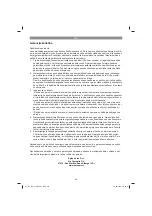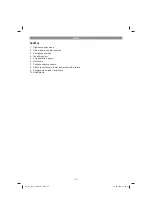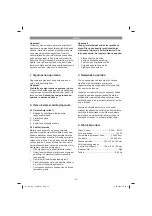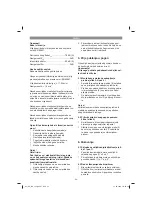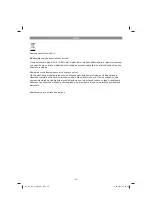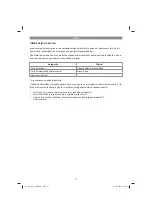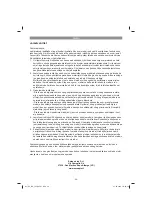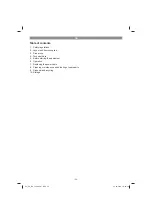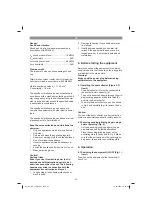
GB
- 33 -
6.2 Working with the Multiple Grinder/Sander
•
Place the whole surface area of the sanding
disk on the material.
•
Switch on the machine and move it with gent-
le pressure over the workpiece completely
circular movements or moving it to and fro
and up and down.
•
Use a coarse paper for coarse sanding and a
finer paper for finish sanding. You can find the
best paper for the job by means of testing.
Caution!
The dust generated when working with the machi-
ne may be harmful.
•
Always wear goggles and a dust mask when
carrying out sanding/grinding work.
•
Everybody who uses the machine or enters
the workplace must wear a dust mask.
•
Do not eat, drink or smoke at the workplace.
•
Do not use the machine on paints which con-
tain lead.
7. Replacing the power cable
Danger!
If the power cable for this equipment is damaged,
it must be replaced by the manufacturer or its
after-sales service or similarly trained personnel
to avoid danger.
8. Cleaning, maintenance and
ordering of spare parts
Danger!
Always pull out the mains power plug before star-
ting any cleaning work.
8.1 Cleaning
•
Keep all safety devices, air vents and the
motor housing free of dirt and dust as far as
possible. Wipe the equipment with a clean
cloth or blow it with compressed air at low
pressure.
•
We recommend that you clean the device
immediately each time you have finished
using it.
•
Clean the equipment regularly with a moist
cloth and some soft soap. Do not use
cleaning agents or solvents; these could at-
tack the plastic parts of the equipment. Ensu-
re that no water can seep into the device. The
ingress of water into an electric tool increases
the risk of an electric shock.
8.2 Carbon brushes
In case of excessive sparking, have the carbon
brushes checked only by a quali
fi
ed electrician.
Danger!
The carbon brushes should not be rep
laced by anyone but a quali
fi
ed electrician.
8.3 Maintenance
There are no parts inside the equipment which
require additional maintenance.
9. Disposal and recycling
The equipment is supplied in packaging to pre-
vent it from being damaged in transit. The raw
materials in this packaging can be reused or
recycled. The equipment and its accessories are
made of various types of material, such as metal
and plastic. Never place defective equipment in
your household refuse. The equipment should
be taken to a suitable collection center for proper
disposal. If you do not know the whereabouts of
such a collection point, you should ask in your
local council o
ffi
ces.
10. Storage
Store the equipment and accessories in a dark
and dry place at above freezing temperature. The
ideal storage temperature is between 5 and 30
°C. Store the electric tool in its original packaging.
Anl_ES_OS_1320_SPK7.indb 33
Anl_ES_OS_1320_SPK7.indb 33
31.01.2019 10:59:58
31.01.2019 10:59:58


